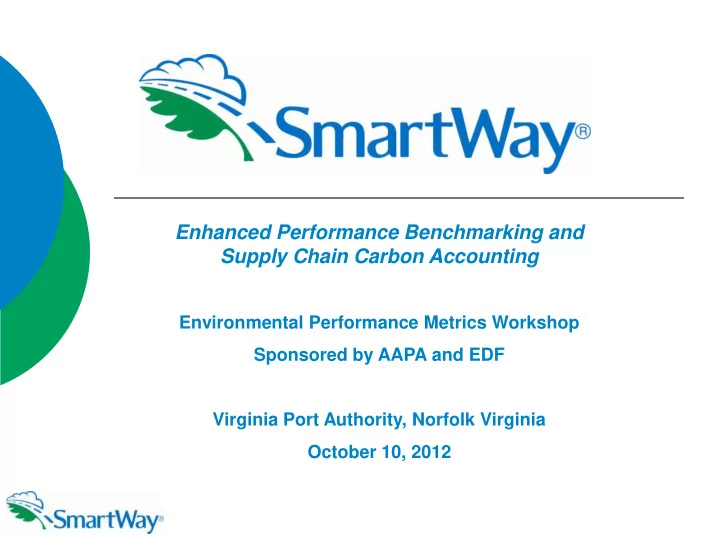

Enhanced Performance Benchmarking and Supply Chain Carbon Accounting Environmental Performance Metrics Workshop Sponsored by AAPA and EDF Virginia Port Authority, Norfolk Virginia October 10, 2012
Today’s Discussion Transportation and Freight Sectors • Environmental & Economic Impact • Marketplace changes and challenges Corporate Citizenship and Carbon • Environmental & Economic Drivers • Business case for freight sustainability What is SmartWay? • Carbon accounting system • 2 nd Generation program enhancements 2
Transportation Sector: Environmental Impacts 2010 U.S. GHG Inventory Totals Transportation accounts for: Over 1/4 of total U.S. GHG T ransportation emissions; (1839 MMT) 27% About 2/3 of U.S. petroleum- based fuel use. O ther Sources (47789 MMT) 70% Non- Transportation Mobile (204 MMT) 3% MMT = Million Metric Ton 2010 Data - Inventory of U.S. Greenhouse Gas Emissions and Sinks (EPA 2012) 3
Freight Sector: Environmental Impacts Transportation Greenhouse Gases 2% 2% 4% Light-Duty Trucks 8% In Transport Sector: 19% Passenger Cars • Freight accounts for Medium & Heavy-Duty over 25% of all fuel Trucks consumed and GHGs Aviation 22% emitted. Marine 43% • Freight is the fastest Rail growing source of Other GHGs. 2010 Data - Inventory of U.S. Greenhouse Gas Emissions and Sinks (EPA 2012) 4
Freight Sector: Economic Impacts Freight transportation is cornerstone of U.S. economy • Trucking & rail deliver goods and materials that drive economic growth and development • Freight shipments value $11 trillion annually • Domestic commodity shipments, domestic transport of exports, imports Logistics economic activity creates $1.3 trillion in U.S. • Represents 8.5% of GDP Trucking alone generates $629 billion in revenues • Employs almost 9 million people 5
Conventional Pollutants from U.S. Transportation Projections for 2017 NO X Emissions VOC Emissions PM 2.5 Emissions NO X Mobile Source VOC Mobile Source PM 2.5 Mobile Source Emissions Emissions Emissions 6 6
Changing Needs of Industry Customer and Consumer awareness Demanding corporate citizenship and accountability Investor, Lender and Insurer requirements Assessing climate risk and business opportunities Rising and volatile energy prices Fuel and driver wages continue to be largest cost centers for truck carriers: 62% of operating costs in 2011 Globalization of supply chains Increasing global opportunities and global competition Other countries’ carbon reporting requirements 7
Energy Challenges Weekly on-highway diesel prices Source: U.S. Energy Information Administration 8
Shared Goals of Carbon Reduction Operational Risk Management Efficiency Carbon Reduction Economic Energy Security Development 9
How to Address Supply Chain Carbon Measure Supply Chain Footprint Improve Benchmark Efficiency Performance Report Innovate Operations Results 10
2 nd Generation SmartWay Standardized tools and information needed to help freight sector measure, benchmark and report supply chain environmental performance • Performance based assessment Information to help industry innovate carrier, modal, and technology choices that improve performance, save fuel and reduce costs • Data on carrier, modal and operational efficiencies • Technology verification program Market incentives and recognition for top performers • Visibility, awards and logo qualification 11
SmartWay = Continuous Improvement Public-private partnership with freight sector Market based, voluntary and free Industry standard carbon accounting system • Standardized tools and metrics for collecting & reporting data • Developed with extensive stakeholder input and peer reviewed Goal: Move more freight, more miles with less emissions, and less energy How: Accelerate adoption of advanced technologies and operational practices in the freight supply chain Measured by saving: • gallons of fuel, barrels of oil, $ • CO 2 , NOx and PM emissions 12
SmartWay Carrier Benchmarking 15 Carrier Categories Quintile Rankings - (TL, LTL, Refrigerated, Tanker, etc.) (ex: Truckload CO 2 g/mile) 8 Emission Metrics Top 20% • 1550 g/mile TL Dry Vans SmartWay Carrier Rating Second Pollutant Specific Performance Levels • 1650 g/mile 20% TL Dry Vans 5 Middle 4 • 1750 g/mile 20% TL Dry Vans 3 Fourth 2 • 1850 g/mile 20% TL 1 Dry Vans g/mile 0 Bottom CO2 • 1950 g/mile 20% TL NOx g/ton- PM10 Dry Vans mile PM2.5 13
SmartWay for Carbon Reporting Step 1- Complete Step 2 - Generate the Shipper Tool SmartWay Data Reports Step 3 - Use results in: • Benchmarking and Operations • Environmental Reporting • Carbon Disclosure Submittals • Shareholder Response 14
SmartWay for Carbon Optimization Step 1- Complete Shipper Step 2 - Generate Strategies analysis SmartWay Data Reports Step 3 - Use results in: • Performance tracking • Progress reporting • Case Studies 15
SmartWay Value Proposition Established program and industry standard • Adopted by industry leaders Advancing the freight sector • Address marketplace needs and challenges Voluntary and market-based incentives • Simple, no-cost participation process Credible, neutral data oversight • EPA collects and processes data for industry Brand equity and public awareness • Mark of cleaner, more efficient transportation 16
2 nd Generation Program Enhancements SmartWay program expansion in Canada • Natural Resources Canada accepting new Partners Fuel Efficient Driver Training • Online Driver training e-learning portal SmartWay Excellence Awards • Based on performance indicators in new tools SmartWay Logo • Enhanced logo qualification requirements Data Quality Program • QA/QC guidelines in development Partner education • Website enhancements, webinars, new bulletins 17
SmartWay Snapshot Since 2004, SmartWay has grown to about 3,000 partners with broad freight industry support - Top 100 U.S. truck carriers - All Class 1 rail lines - Fortune 500 shippers from every major business sector - Major logistics firms Since 2004, SmartWay Partners saved: - 23.6 million metric tons of CO2 - 478,000 tons NOx - 55 million barrels of oil - 22,000 tons PM - $6.5 billion dollars in fuel costs Equivalent to taking over 3 million cars off the road for 1 year 18
For more information: www.epa.gov/smartway smartway_transport@epa.gov SmartWay Helpline 734-214-4767 19
Recommend
More recommend